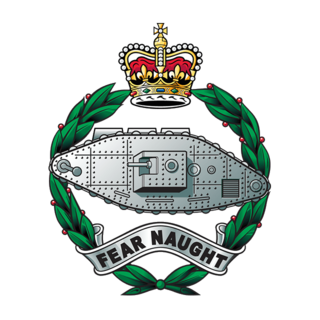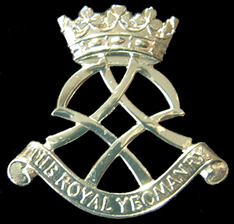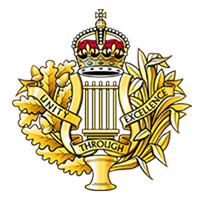
The Royal Armoured Corps is the armoured arm of the British Army, that together with the Household Cavalry provides its armour capability, with vehicles such as the Challenger 2 and the Warrior tracked armoured vehicle. It includes most of the Army's armoured regiments, both the Royal Tank Regiment and those converted from old horse cavalry regiments. Today it comprises twelve regiments, eight regular and four Army Reserve. Although the Household Cavalry Regiment provide an armoured regiment, they are not part of the RAC.

Brigade of Gurkhas is the collective name which refers to all the units in the British Army that are composed of Nepalese Gurkha soldiers. The brigade draws its heritage from Gurkha units that originally served in the British Indian Army prior to Indian independence, and prior to that served for the East India Company. The brigade includes infantry, engineering, signal, logistic and training and support units. They are known for their khukuri, a distinctive heavy knife with a curved blade, and have a reputation for being fierce and brave soldiers.
The Scots Guards are a regiment of the British Army. The regiment takes part in numerous events, most notably the Beating Retreat, Changing of the Guard, Queen's Birthday Parade, Remembrance Sunday and State Visits. The Guards' regiments ceremonial uniforms differ from each other only slightly, the differentiations being in the tunic and the type of plume on the bearskin, if any, they have. The Scots Guards uniform consists of tunic buttons in threes, the Order of the Thistle on the shoulder badge, the Thistle on the collar badge and no plume on the bearskin.
Options for Change was a restructuring of the British Armed Forces in summer 1990 after the end of the Cold War.

Catterick Garrison is a major garrison and military town 3 miles (5 km) south of Richmond, North Yorkshire, England. It is the largest British Army garrison in the world, with a population of around 13,000 in 2017 and covering over 2,400 acres. Under plans announced by the Ministry of Defence (MoD) in November 2005, its population is expected to grow to over 25,000, making it the largest population centre in the local area.

The Royal Tank Regiment (RTR) is the oldest tank unit in the world, being formed by the British Army in 1916 during the First World War. Today, it is the armoured regiment of the British Army's 12th Armoured Infantry Brigade. Formerly known as the Tank Corps and the Royal Tank Corps, it is part of the Royal Armoured Corps.

The Royal Yeomanry (RY) is the senior reserve cavalry regiment of the British Army. Equipped with Supacat Jackal variants, their role is to conduct mounted and dismounted formation reconnaissance. The Regimental Headquarters is located in Leicester, with squadrons in Fulham, Nottingham, Dudley, Croydon, Telford, and Leicester. The regiment is part of the Royal Armoured Corps and is only reserve cavalry regiment to resubordinate into regular brigade as part of the Future Soldier Programme, which in turn arose from the Integrated Review of Security, Defence, Development and Foreign Policy published in March 2021.

The Royal Corps of Army Music is a Corps of the British Army dedicated to the provision and promotion of military music.

The Queen's Royal Hussars (The Queen's Own and Royal Irish) (QRH) is a British armoured regiment. It was formed on 1 September 1993 from the amalgamation of the Queen's Own Hussars and the Queen's Royal Irish Hussars. The regiment and its antecedents have been awarded 172 Battle Honours and eight Victoria Crosses. The regiment was based in Sennelager, Germany, until 2019 when it was relocated to Tidworth Camp, England. It is the armoured regiment for 20th Armoured Brigade Combat Team.

The Prince of Wales's Own Regiment of Yorkshire was an infantry regiment of the British Army, part of the King's Division. It was created in 1958 by the amalgamation of the West Yorkshire Regiment and the East Yorkshire Regiment. After 48 years service, the regiment was amalgamated again, this time with two other Yorkshire regiments. It became the 1st Battalion of the Yorkshire Regiment, with the Green Howards forming the 2nd Battalion and the Duke of Wellington's Regiment forming the 3rd Battalion on 6 June 2006. Following further merges, in 2012, the battalion was redesignated as the new 2nd Battalion (2Yorks).

The Royal Dragoon Guards (RDG) is a cavalry regiment of the British Army. It was formed in 1992 by the amalgamation of two other regiments: The 4th/7th Royal Dragoon Guards and the 5th Royal Inniskilling Dragoon Guards. Based in Battlesbury Barracks, Wiltshire, the regiment currently serves as the armoured cavalry reconnaissance unit of 20th Armoured Brigade Combat Team. Previously equipped with the Scimitar armoured reconnaissance vehicle, it started converting to the Warrior tracked armoured vehicle in 2022.

The 1st Armoured Infantry Brigade was an infantry brigade of the British Army with a long history including service during both the First and the Second World Wars. It was based at Tidworth Camp. Previously, it has been designated 1st (Guards) Brigade, 1st Infantry Brigade, 1st Mechanised Brigade, and under the initial Army 2020 reforms assumed the title of 1st Armoured Infantry Brigade. Under the Future Soldier programme, the brigade merged with the 1st Artillery Brigade to form the 1st Deep Recce Strike Brigade Combat Team.

Battlesbury Barracks is a British Army installation in Warminster, Wiltshire, England. It is the permanent base of the Royal Dragoon Guards, serving as armoured cavalry.

The page contains the current structure of the British Army. The British Army is currently being reorganised to the Future Soldier structure.

The Royal Lancers (Queen Elizabeths' Own) is a cavalry regiment of the British Army. The regiment was formed by an amalgamation of 9th/12th Royal Lancers (Prince of Wales's) and the Queen's Royal Lancers on 2 May 2015. It serves in the 1st Deep Recce Strike Brigade Combat Team. The Royal Lancers are part of the 3rd (UK) Division.
The following is a hierarchical outline for the structure of the British Army in 1989. The most authoritative source for this type of information available is Ministry of Defence, Master Order of Battle, and United Kingdom Land Forces, HQ UKLF, UKLF ORBAT Review Action Plan, HQ UKLF, 1990.
Future Soldier is a reform of the British Army resulting from the Integrated Review of Security, Defence, Development and Foreign Policy published in March 2021. The aim of the reform is to create a more lethal, agile and expeditionary force, able to fight and win wars and to operate in the grey-zone between peace and war. Future Soldier was published on 25 November 2021 and deals with the organizational changes of the British Army, with changes to personnel and equipment were set out in the Defence in a Competitive Age paper published on 22 March 2021.
The 1st Deep Reconnaissance Strike Brigade Combat Team is a formation of the British Army, currently headquartered in Delhi Barracks, Tidworth Camp, Wiltshire, as part of the 3rd Division.

The Heavy Cavalry and Cambrai Band is a former military band of the Corps of Army Music, belonging to the British Army. Following the Army 2020 programme, the band was amalgamated with the Light Cavalry Band in early 2014 to form the new Band of the Royal Armoured Corps.












